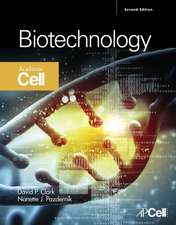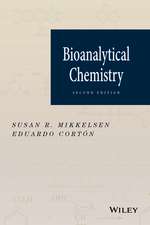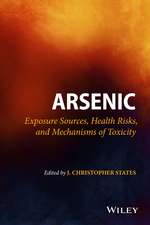Biochemistry of the Essential Ultratrace Elements: Biochemistry of the Elements, cartea 3
Editat de Earl Friedenen Limba Engleză Paperback – 25 feb 2012
Din seria Biochemistry of the Elements
- 15%
 Preț: 647.08 lei
Preț: 647.08 lei - 5%
 Preț: 1620.56 lei
Preț: 1620.56 lei - 5%
 Preț: 1102.82 lei
Preț: 1102.82 lei - 18%
 Preț: 1222.94 lei
Preț: 1222.94 lei - 18%
 Preț: 946.72 lei
Preț: 946.72 lei - 15%
 Preț: 640.88 lei
Preț: 640.88 lei - 15%
 Preț: 642.83 lei
Preț: 642.83 lei - 15%
 Preț: 600.90 lei
Preț: 600.90 lei - 15%
 Preț: 640.71 lei
Preț: 640.71 lei - 5%
 Preț: 373.68 lei
Preț: 373.68 lei - 18%
 Preț: 1230.84 lei
Preț: 1230.84 lei - 15%
 Preț: 648.42 lei
Preț: 648.42 lei - 15%
 Preț: 649.71 lei
Preț: 649.71 lei - 5%
 Preț: 369.29 lei
Preț: 369.29 lei - 5%
 Preț: 720.47 lei
Preț: 720.47 lei
Preț: 646.75 lei
Preț vechi: 760.88 lei
-15% Nou
Puncte Express: 970
Preț estimativ în valută:
123.77€ • 128.74$ • 102.18£
123.77€ • 128.74$ • 102.18£
Carte tipărită la comandă
Livrare economică 14-28 aprilie
Preluare comenzi: 021 569.72.76
Specificații
ISBN-13: 9781468447774
ISBN-10: 1468447777
Pagini: 448
Ilustrații: 444 p.
Dimensiuni: 152 x 229 x 24 mm
Greutate: 0.59 kg
Ediția:Softcover reprint of the original 1st ed. 1984
Editura: Springer Us
Colecția Springer
Seria Biochemistry of the Elements
Locul publicării:New York, NY, United States
ISBN-10: 1468447777
Pagini: 448
Ilustrații: 444 p.
Dimensiuni: 152 x 229 x 24 mm
Greutate: 0.59 kg
Ediția:Softcover reprint of the original 1st ed. 1984
Editura: Springer Us
Colecția Springer
Seria Biochemistry of the Elements
Locul publicării:New York, NY, United States
Public țintă
ResearchCuprins
1. A Survey of the Essential Biochemical Elements.- 1.1 Essentiality.- 1.2 A Survey of the Biochemistry of the Elements.- 1.3 Mechanism of Action of the Essential Ultratrace Elements.- 1.4 Summary.- General References.- Specific References.- 2. The Discovery of the Essential Trace Elements: An Outline of the History of Biological Trace Element Research.- 2.1 Introduction.- 2.2 Classification of the Bioelements.- 2.3 The Concept of Essentiality.- 2.4 Trace Element Discoveries from 1925 to 1956.- 2.5 Discoveries from 1956 to 1978: The Era of Klaus Schwarz.- 2.6 Current Trends and Problems.- References.- 3. Iodine.- 3.1 Introduction.- 3.2 Chemistry of Iodine and Iodoamino Acids.- 3.3 Iodine Metabolism.- 3.4 Mechanism of Action of Thyroid Hormones.- 3.5 Summary.- References.- 4. Fluorine.- 4.1 Introduction.- 4.2 Fluoride in Cells and Tissues.- 4.3 Fluoride Deficiency and Function.- 4.4 Metabolism and Toxicity of Fluoride.- 4.5 Summary.- References.- 5. Manganese.- 5.1 Introduction.- 5.2 Manganese Concentration in Animal Tissues.- 5.3 Metabolism of Manganese.- 5.4 Biochemistry of Manganese.- 5.5 Manganese Nutrition.- 5.6 Manganese Toxicity.- 5.7 Manganese in Relation to Immunocompetence and Cancer.- 5.8 Summary.- References.- 6. Cobalt.- 6.1 Introduction and History.- 6.2 Cobalt and Its Compounds in Cells and Tissues.- 6.3 Cobalt Deficiency and Function.- 6.4 Metabolism and Toxicity of Cobalt.- 6.5 Conclusion.- References.- 7. Molybdenum.- 7.1 Introduction and History.- 7.2 Molybdenum and Its Compounds in Cells and Tissues.- 7.3 Nutritional Aspects of Molybdenum.- 7.4 Conclusion.- 7.5 Summary.- References.- 8. Chromium.- 8.1 Introduction.- 8.2 Chromium: Physical and Chemical Properties.- 8.3 Biologically Active Chromium.- 8.4 Absorption and Transport of Chromium.- 8.5 Chromium Occurrence in Blood, Tissues, and Hair.- 8.6 Chromium Excretion.- 8.7 Functions of Chromium and Signs of Chromium Deficiency.- 8.8 Factors Affecting Chromium Metabolism.- 8.9 Chromium and Stress.- 8.10 Dietary Requirements of Chromium.- 8.11 Effects of Chromium Supplementation.- 8.12 Toxicity of Chromium.- 8.13 Summary.- References.- 9. Selenium.- 9.1 Introduction and History.- 9.2 Selenium and its Compounds in Cells and Tissues.- 9.3 Selenium Deficiency and Function.- 9.4 Metabolism and Toxicity of Selenium.- 9.5 Summary.- References.- 10. Vanadium.- 10.1 Introduction and History.- 10.2 Vanadium in Tissues.- 10.3 Vanadium Deficiency and Function.- 10.4 Vanadium Metabolism.- 10.5 Vanadium Toxicity.- 10.6 Summary.- References.- 11. Silicon.- 11.1 Introduction.- 11.2 Silicon in Tissues.- 11.3 Silicon Deficiency and Functions.- 11.4 Metabolism.- 11.5 Toxicity.- 11.6 Summary.- References.- 12. Nickel.- 12.1 Introduction and History.- 12.2 Nickel and Its Compounds in Cells and Tissues.- 12.3 Nickel Deficiency.- 12.4 Nickel Function.- 12.5 Biological Interactions between Nickel and Other Trace Elements.- 12.6 Nickel Metabolism and Toxicity.- 12.7 Summary.- References.- 13. Tin.- 13.1 Introduction.- 13.2 Tin in Cells and Tissues.- 13.3 Deficiency and Function.- 13.4 Metabolism and Toxicity.- 13.5 Summary.- References.- 14. Arsenic.- 14.1 Introduction and History.- 14.2 Arsenic and Its Compounds in Cells and Tissues.- 14.3 Arsenic Deficiency and Interaction with Other Nutrients.- 14.4 Arsenic Function.- 14.5 Arsenic Metabolism.- 14.6 Arsenic Toxicity.- 14.7 Summary.- References.- 15. Cadmium.- 15.1 Introduction.- 15.2 Chemistry of Cadmium: Biological Perspectives.- 15.3 Evidence for the Possible Essentiality of Cadmium.- 15.4 Metabolism of Cadmium.- 15.5 Biochemical Effectsof Cadmium.- 15.6 Summary.- References.- 16. Lead.- 16.1 Introduction and History.- 16.2 Metabolism of Lead.- 16.3 Lead Deficiency.- 16.4 Toxicity of Lead.- 16.5 Conclusions.- References.- 17. Boron.- 17.1 Boron in Biology.- 17.2 Carbohydrate Metabolism.- 17.3 Hormone Action.- 17.4 Membrane Structure and Function.- 17.5 Nucleic Acid Biosynthesis.- 17.6 Summary.- References.












